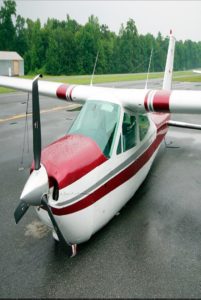Gear-up Accidents:
They Can Happen to Anybody!
By Steve Petrich
It is well known within the General Aviation community that gear-up landings have been a problem ever since the invention of retractable landing gear. In spite of the legendary “GUMP” checks, etc, these inadvertent events happen across a broad spectrum of pilots and continue to occur all too frequently.
A recent NTSB report showed that an average of one such preventable accident is reported every week in the U.S. alone. Meanwhile, the American Bonanza Society estimates that there are three gear related mishaps (gear-up and gear collapse) per week. (https://www.youtube.com/watch?v=Mle7DxDgQfg).

Because gear-up landings typically don’t fit the FAA definition of an accident (“in which any person suffers death or serious injury, or in which the aircraft receives substantial damage”), they do not require the filing of an NTSB Accident/Incident Report. As a result, an unknown number of these events fly under the radar of GA safety records and therefore are never counted. The insurance underwriters know how many gear-up claims actually take place, but their data is kept confidential.
If you dig further into the statistics, you will see that these events happen to private pilots, commercial pilots, military pilots, ATP’s and even during training with CFI’s. They also happen to pilots with a wide range of flight time and experience. The most common denominator in an inadvertent gear-up landing is some type of distraction in the cockpit like ATC communications, go-arounds, fighting a crosswind, passenger conversation, etc.
The good news about gear-up landings is that they seldom result in injuries or fatalities. However, the bad news is that the cost of repairs can quickly add up: engine, propeller and airframe repairs are getting more expensive than ever. Shops that specialize in gear-up repairs estimate that the cost to fix a single-engine aircraft will typically run upwards of $60,000. That amount can easily double for a light twin. Insurance deductibles come into play and there is a very good possibility that higher insurance premiums will be forthcoming. Depending on the individual pilot age, his/her history and the circumstances surrounding the event, such a mishap often puts one in a higher risk category, or may even force them out of flying. (https://www.youtube.com/watch?v=ZiKTsbURiLc)

Most original factory gear warning horns got certified back in the days when nobody wore a headset (let alone a noise-cancelling variety) and were heard solely over the cabin speaker. Today, headsets are worn by nearly every pilot and the ANR type are more popular than ever. As a result, the typical factory warning horns may be difficult to hear… if they can be heard at all.
It would be ideal if planes were smart enough to extend the landing gear automatically at the proper time or to have someone onboard on every flight whose sole purpose was just to remind the pilot to verify the landing gear position upon approach to landing. Unfortunately, that automatic system has yet to be perfected and many pilots are often flying solo.
A smart investment today is an aftermarket supplemental gear position warning system. With one, you have the redundancy of having two means to keep the pilot from joining the infamous “Gear-Up Club”. It is an essential safety device — as putting a plane down on its belly is a stressful, costly and embarrassing experience that no pilot wants or needs. Whichever brand of alerting device is purchased, it should be STC’d and rely on a different method of activation than the one that was originally certified in the aircraft.
Until the airplane manufacturers install foolproof gear warning systems on all GA planes or insurance companies require them as a proactive accident prevention tool, aircraft owners can significantly lessen the odds of experiencing the high cost of gear-up mishaps by avoiding distractions and installing a supplemental gear position warning system in their aircraft.
Steve Petrich is the President of P2 Aviation Technology, Inc. in Minneapolis MN and has over 45 years of experience as a GA and Professional pilot. For more info on gear position warning systems, visit www.P2inc.com.
https://asrs.arc.nasa.gov/docs/cb/cb_399.pdf
https://airfactsjournal.com/2018/05/landing-gear-up-how-the-unthinkable-happened-to-me/
https://www.flightsafetyaustralia.com/2015/11/those-who-wont-avoiding-gear-up-landings/



